The Sumida River Pilgrimage to the Seven Deities of Good Fortune
The Origins of the Seven Deities of Good Fortune
The seven essential virtues have been treasured by mankind throughout much of history. Fortune, longevity, popularity, integrity, amiability, power and magnanimity became associated with Shinto and Buddhist saints. In Japan the seven deities of good fortune have been symbols of these auspicious virtues since the late Muromachi period. Since the late Edo period it has been a popular custom among townsfolk to make a pilgrimage to the seven deities of good fortune and pray for happiness in the coming year.
●More about The Sumida River Pilgrimage to the Seven Deities of Good Fortune・・・・
http://members2.jcom.home.ne.jp/sirahige/
The seven essential virtues have been treasured by mankind throughout much of history. Fortune, longevity, popularity, integrity, amiability, power and magnanimity became associated with Shinto and Buddhist saints. In Japan the seven deities of good fortune have been symbols of these auspicious virtues since the late Muromachi period. Since the late Edo period it has been a popular custom among townsfolk to make a pilgrimage to the seven deities of good fortune and pray for happiness in the coming year.
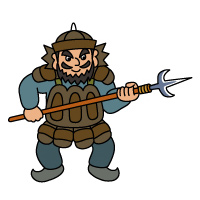 | Tamon Temple:Bishamonten (Power) Bishamonten is from India. Clad in armor, with a spear in his right hand and a two-storied pagoda in his left, he is armed and fierce. When portrayed as a guardian and one of the four heavenly kings, he is Tamonten but as one of the seven deities of good fortune he is called Bishamonten. |
 | Shirahige Shrine: Jurojin (Longevity). Jurojin is the Chinese deity of long life and carries a staff with a scroll tied to it. He is accompanied by a deer, the symbol of a lifespan of three thousand years. |
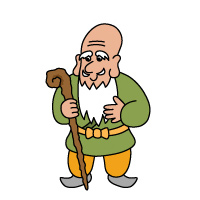 | Hyakka Garden: Fukurokuju (Popularity) Fukurokuju is a Chinese deity who is thought to be the embodiment of the south polar star. He is accompanied by a crane or tortoise. |
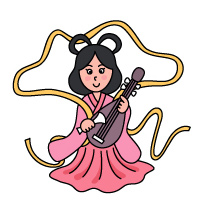 | Chomei Temple: Benzaiten (Amiability) Benzaiten is a sea goddess from India. She plays the biwa (Japanese lute) and is a patroness of music, oratory and prosperity. |
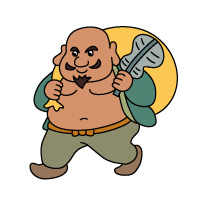 | Kofuku Temple: Lord Hotei (Magnanimity) Hotei is from China where he was a Zen monk. This plump and cheerful figure carries a large bag over his back from which he dispenses joy. Innocent and simple, he guides us to the richness of life without greed. |
 | Mimeguri Shrine: Ebisu (Integrity) Ebisu holds a fishing rod in his right hand and a large sea bream dangles from his left hand. He was very popular among the thriving merchants of the Muromachi period who embraced him as the deity of business prosperity. |
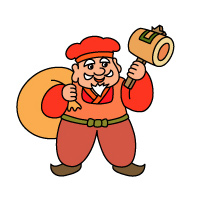 | Mimeguri Shrine: Daikoku (Fortune) Daikoku is from India and also called Daikokuten. He carries a small mallet in his right hand and stands on bales of rice. Often paired with Ebisu, he is the kitchen deity. |
●More about The Sumida River Pilgrimage to the Seven Deities of Good Fortune・・・・
http://members2.jcom.home.ne.jp/sirahige/
Information about the Joraku Pagoda: a Group Repository for Everlasting Repose
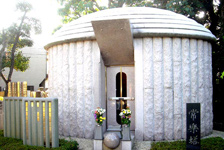
■Qualifications
Supporters of the Shingon-Chisan Tamon Temple receive a Buddhist memorial service, posthumous name and interment of ashes. (No restrictions on denomination, nationality, sex or age.)
■Group Ceremonies
Rites during Higan week on the day of the spring equinox
O-Segaki (Feeding of the Hungry Ghosts) May 9
The O-Bon Festival (Feast of Lanterns) July 15
Rites during Higan week on the day of the fall equinox
■Expenses
1. A sum of \300,000 for group interment of the ashes
2. A sum of \700,000 for enshrinement of the ashes in an funerary urn, group interment and observances of the first, second, sixth and twelfth year anniversaries.
■The following are included in the above expenses
1. Offerings for the interment ceremony
2. Manufacture and installation of a standard funerary plate with posthumous name, secular name and date of death.
3. Offerings for the second-anniversary memorial service.
■Other
There are no maintenance or administrative fees.
Supporters of the Shingon-Chisan Tamon Temple receive a Buddhist memorial service, posthumous name and interment of ashes. (No restrictions on denomination, nationality, sex or age.)
■Group Ceremonies
Rites during Higan week on the day of the spring equinox
O-Segaki (Feeding of the Hungry Ghosts) May 9
The O-Bon Festival (Feast of Lanterns) July 15
Rites during Higan week on the day of the fall equinox
■Expenses
1. A sum of \300,000 for group interment of the ashes
2. A sum of \700,000 for enshrinement of the ashes in an funerary urn, group interment and observances of the first, second, sixth and twelfth year anniversaries.
■The following are included in the above expenses
1. Offerings for the interment ceremony
2. Manufacture and installation of a standard funerary plate with posthumous name, secular name and date of death.
3. Offerings for the second-anniversary memorial service.
■Other
There are no maintenance or administrative fees.
Shingon-Chisan Buddhism Sumidasan Kisshoin Tamon Temple
TEL:03-3616-6002 ADRESS:31-13, Sumida 5-Chome Sumida-ku, Tokyo ...Copyright 2007 sumidasan-tamonji...
TEL:03-3616-6002 ADRESS:31-13, Sumida 5-Chome Sumida-ku, Tokyo ...Copyright 2007 sumidasan-tamonji...